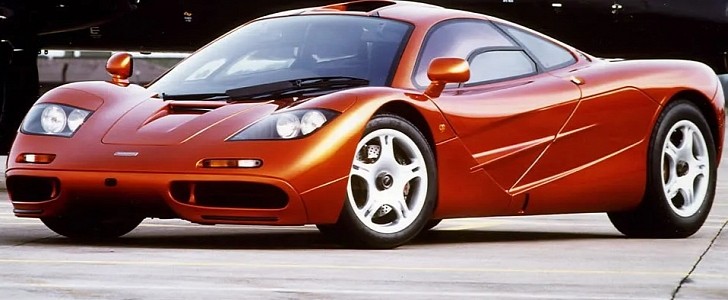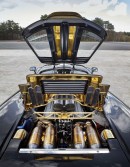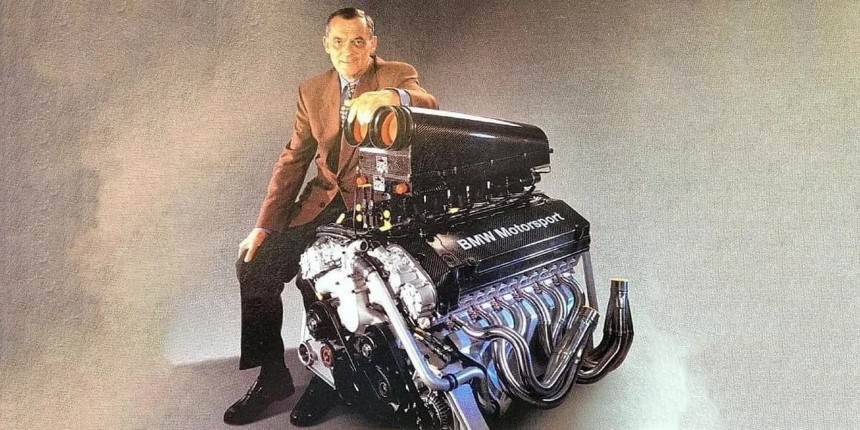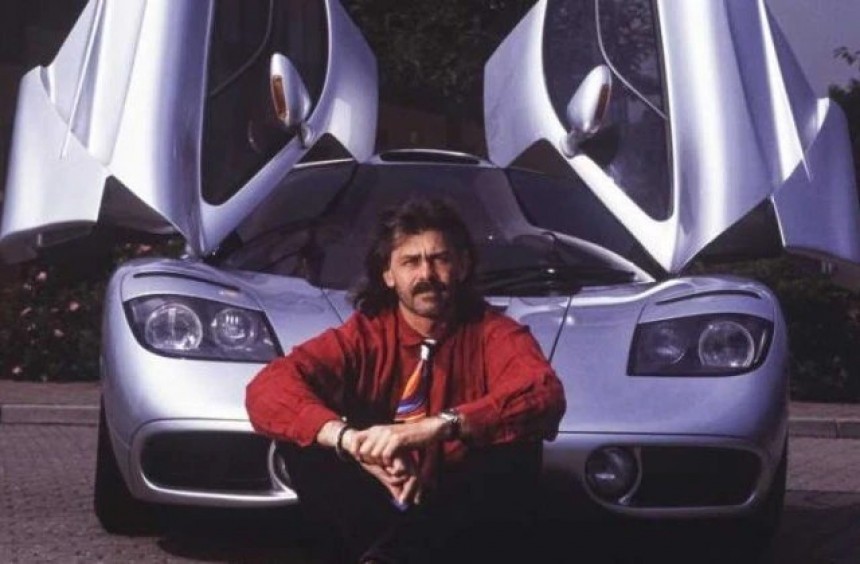Gordon Murray is the kind of man who takes compromises to his grand displays of engineering like a personal insult. Not because he's an unhinged rage monster like so many of his auto industry contemporaries. It's because he has a proven track record of being completely right about things petrolheads care about the most.
That's why the story behind just the engine in Murray's Mclaren F1 early 90s hypercar is just as interesting and compelling as the rest of the car. The manufacturer Murray ultimately chose to go with in his prized claim to fame was selected meticulously and methodically. No manufacturer was off the table. Be it British, American, German, or JDM engine makers, whoever could build the most powerful and most reliable engine would have Murray's blessing.
By his own admission, Gordon Murray took test drives in some of the greatest supercars of the late 80s and early 90s. Heavyweights like the Jaguar XJ220, the Bugatti EB 110, and the first Lamborghini Diablos. He found that apart from them all being fantastic, each engine had strengths and weaknesses in different areas.
Traits that set them apart from each other in far more of a subtle but very definite manner that the average hatchback driver could never even fathom. Murray's goal was simple, identify these positive traits and forge them into an engine that he himself was satisfied with enough to sign off on in his leadership of the F1 program.
If anyone on planet Earth had both the wherewithal and the clout to make an informed and accurate judgment on the tiny intricacies that made each supercar and the engine there-in so special, Gordon Murray. Before his days as an exotic hypercar designer, his career was as a lead engineer in Formula One racing.
At that time, the F1 engines were making more power than even many of today's race cars. In fact, it was through his connections during his tenure with the English Motor Racing Developments Ltd, commonly called Brabham Racing, that Murray finally found a suitable engine for a car of his own creation.
The connection in question was a German fellow called Paul Rosche, one of the brightest and most skilled auto engineers of the rapidly recovering and thriving post-Second World War German Republic. Rosche was born in Munich in 1934 and joined BMW at the age of 23. His claims to fame before a chance encounter with Gordon Murray in 1990 was as BMW's principal engine designer for their in-house racing team, for which he earned well over 100 awards as a manufacturer.
Other accolades include designing the engines for the e30 BMW M3, the original M1 supercar, and the spectacular 2002 Turbo. The point is, this man lived, breathed, and exhaled internal combustion engines. So when Murray and Rosche met for a chat after a 1990 Grand Prix, the two couldn't have been in more of the right place at the right time. Shortly prior, Murray had been eyeballs-deep in negotiations with Honda for the very same position ultimately taken by M Division. Honda, of course, was no stranger to performance engines.
Their participation in Rally Racing, Indy Car, CART Series Racing, and, of course, Formula One and Two is a surefire testament to this. But auto executives can often be fickle people, both short-tempered and short-sighted. So instead of greenlighting a project that would have set them in the history books forever, Honda decided to withdraw their negotiations from consideration. Itching to get things back on track, Gordon Murray made M-Division the heart and soul of what was to become the McLaren F1.
The finished product was called the BMW S70/2. A naturally aspirated V12 that even modern engine builders can only aspire to in 2022. People marvel today at the 670 horsepower (679 PS) LT6 V8 powered Corvette C8 Z06. Well, let us remind you the 1995 F1 LM jetted one more horsepower, and it had a top speed of well over 40 miles per hour (64 kph) faster. 225 miles per hour (362 kph) to the Z06's 196 mph (315 kph).
When it was launched in 1992, the McLaren F1 cost was a staggering $815,000, and that's without the gargantuan taxes and fees you were also likely to pay back then. Obviously, that figure is considerably more now. The car could host three people inside in a rather unusual position. The driver seat was in the middle, flanked by the other two occupants, positioned slightly behind.
Nowadays, that same car is worth 25 to 30 times that much money. Some of the most famous petrolhead celebrities took ownership of Gordon Murray's pride and joy. Including Jay Leno, Rowan Atkinson, and in a move he probably wants you to forget nowadays, Elon Musk as well.
They were all hopelessly seduced by a car with an engine like a roaring lion and a designer who grows more and more every day into a Thomas Edison or Albert Einstein-like status in his very niche engineering field. Meaning, of course, he's the very best in the world at what he does. That's why at age 75, he is still at it with the T50, the F1s spiritual V12 successor.
Stay tuned for more from BMW M Month here on autoevolution.
By his own admission, Gordon Murray took test drives in some of the greatest supercars of the late 80s and early 90s. Heavyweights like the Jaguar XJ220, the Bugatti EB 110, and the first Lamborghini Diablos. He found that apart from them all being fantastic, each engine had strengths and weaknesses in different areas.
Traits that set them apart from each other in far more of a subtle but very definite manner that the average hatchback driver could never even fathom. Murray's goal was simple, identify these positive traits and forge them into an engine that he himself was satisfied with enough to sign off on in his leadership of the F1 program.
If anyone on planet Earth had both the wherewithal and the clout to make an informed and accurate judgment on the tiny intricacies that made each supercar and the engine there-in so special, Gordon Murray. Before his days as an exotic hypercar designer, his career was as a lead engineer in Formula One racing.
At that time, the F1 engines were making more power than even many of today's race cars. In fact, it was through his connections during his tenure with the English Motor Racing Developments Ltd, commonly called Brabham Racing, that Murray finally found a suitable engine for a car of his own creation.
The connection in question was a German fellow called Paul Rosche, one of the brightest and most skilled auto engineers of the rapidly recovering and thriving post-Second World War German Republic. Rosche was born in Munich in 1934 and joined BMW at the age of 23. His claims to fame before a chance encounter with Gordon Murray in 1990 was as BMW's principal engine designer for their in-house racing team, for which he earned well over 100 awards as a manufacturer.
Other accolades include designing the engines for the e30 BMW M3, the original M1 supercar, and the spectacular 2002 Turbo. The point is, this man lived, breathed, and exhaled internal combustion engines. So when Murray and Rosche met for a chat after a 1990 Grand Prix, the two couldn't have been in more of the right place at the right time. Shortly prior, Murray had been eyeballs-deep in negotiations with Honda for the very same position ultimately taken by M Division. Honda, of course, was no stranger to performance engines.
Their participation in Rally Racing, Indy Car, CART Series Racing, and, of course, Formula One and Two is a surefire testament to this. But auto executives can often be fickle people, both short-tempered and short-sighted. So instead of greenlighting a project that would have set them in the history books forever, Honda decided to withdraw their negotiations from consideration. Itching to get things back on track, Gordon Murray made M-Division the heart and soul of what was to become the McLaren F1.
When it was launched in 1992, the McLaren F1 cost was a staggering $815,000, and that's without the gargantuan taxes and fees you were also likely to pay back then. Obviously, that figure is considerably more now. The car could host three people inside in a rather unusual position. The driver seat was in the middle, flanked by the other two occupants, positioned slightly behind.
Nowadays, that same car is worth 25 to 30 times that much money. Some of the most famous petrolhead celebrities took ownership of Gordon Murray's pride and joy. Including Jay Leno, Rowan Atkinson, and in a move he probably wants you to forget nowadays, Elon Musk as well.
They were all hopelessly seduced by a car with an engine like a roaring lion and a designer who grows more and more every day into a Thomas Edison or Albert Einstein-like status in his very niche engineering field. Meaning, of course, he's the very best in the world at what he does. That's why at age 75, he is still at it with the T50, the F1s spiritual V12 successor.








